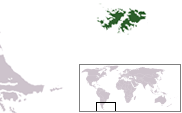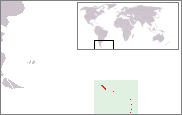Occupation of the Falkland Islands
| Malvinas Islands | ||||||||||
| Islas Malvinas | ||||||||||
| Military occupation by Argentina | ||||||||||
| ||||||||||
 Coat of arms of Argentina
| ||||||||||
| Anthem Himno Nacional Argentino | ||||||||||
 Location of the Falkland Islands (Islas Malvinas). | ||||||||||
 Location of South Georgia and South Sandwich Islands. | ||||||||||
| Capital | Puerto Argentino (Stanley) | |||||||||
| Languages | Spanish (official) English (de facto) | |||||||||
| Government | Dictatorship | |||||||||
| President of Argentina | ||||||||||
| • | 1982 | Leopoldo Galtieri | ||||||||
| Military Commander | ||||||||||
| • | 2 April 1982 | Oswaldo Jorge Garcia | ||||||||
| • | 3 April – 14 June 1982 | Mario Menéndez | ||||||||
| Historical era | Falklands War | |||||||||
| • | Argentine invasion | 2 April 1982 | ||||||||
| • | Argentine surrender | 14 June 1982 | ||||||||
| • | Official dissolution | 15 May 1985 | ||||||||
| Currency | Peso (ARL) | |||||||||
| ||||||||||
| Today part of | | |||||||||
Part of a series on the |
|---|
| History of the Falkland Islands |
 |
| Colonial time |
| Continuous settlement |
| Other |
The occupation of the Falkland Islands and of South Georgia and the South Sandwich Islands (Spanish: Gobernación Militar de las Islas Malvinas, Georgias del Sur y Sandwich del Sur "Military Administration of the Malvinas, South Georgia and South Sandwich Islands") was the short-lived Argentine administration of a group of islands in the South Atlantic whose sovereignty has long been disputed. Until their invasion on 2 April 1982 by the Argentine military junta, they had been governed by the United Kingdom since it re-established control over them in 1833.
The invasion and subsequent occupation signalled the start of the Falklands War, which resulted in the islands returning to British control on 14 June 1982.
Background
The Falkland Islands (Spanish: Islas Malvinas) had been under British administration since January 1833, when the United Kingdom re-established sovereignty over the islands which, at that time, housed an Argentine settlement. Argentina has claimed the Falklands to be part of their territory ever since.[1]
The UK first claimed South Georgia and the South Sandwich Islands in 1843, and incorporated them as Falkland Islands Dependencies in 1908. The Compañía Argentina de Pesca had an operation on South Georgia in the early 20th century, and Argentina had claimed sovereignty over South Georgia since 1927 and the South Sandwich Islands since 1938.[2] In November 1976, Argentina landed and occupied the uninhabited islands of Southern Thule which had been in British possession since the 18th century.[3]
Establishment
In the early hours of 2 April 1982, in the wake of violent anti-government riots in Buenos Aires, the military junta, which ruled Argentina, launched an invasion of the Falkland Islands. Faced with overwhelming Argentine force, Sir Rex Hunt (British Governor of the Islands) surrendered to Admiral Carlos Büsser (the Argentine amphibious force commander) at 9.15am. The next day, Argentina sent troops to capture and occupy South Georgia and the uninhabited South Sandwich Islands.[4]
Historically, Argentina had claimed the islands were part of the then federal territory of Tierra del Fuego and South Atlantic islands. However, on 3 April 1982, the junta issued a decree which separated the islands from the jurisdiction of Tierra del Fuego and named Brigadier General Mario Menéndez as the 'Military Governor of the Malvinas, South Georgia and the South Sandwich Islands'.[5]
74 days
.jpg)
On the first day of the occupation, Governor Hunt and officials from the Foreign Office were forcibly evicted from the islands by the Argentine forces and sent to Montevideo, Uruguay.[4] Argentine troops took over control of the Falkland Islands Broadcasting Studio when Patrick Watts was live on air.[6] The Argentines used the radio station to play tapes with instructions for the islanders and military music including the Argentine National Anthem.[7]
Argentina made Spanish the official language of the Islands and changed Port Stanley's name to Puerto Argentino. Traffic was commanded to drive on the right by painting arrows on the road indicating the direction of traffic and changing the location of street and traffic signs to Spanish and metric system. Argentinian Captain Barry Melbourne Hussey, who was chosen for a position in the administration due to his knowledge and experience of English, asserted safety as a major concern, during discussions with the Islanders: "Which would you prefer, that our eighteen-year-old conscripts, with their big lorries, should try to drive on the left, or that you, with your little vehicles, change to the right?".[8]
However, outside Stanley, most roads were single track anyway and some islanders refused to observe the new rule and continued to drive on the left.[9] Other acts of civil disobedience included Reg Silvey (lighthouse keeper and ham radio enthusiast) broadcasting clandestine radio messages throughout the occupation.[4]
During the 74-day occupation, 114 inhabitants of Goose Green, considered to be potential troublemakers, were imprisoned and 14 residents of Stanley were sent to Fox Bay East and placed under house arrest.[4] The Argentine military evacuated 52 schoolchildren from Stanley and turned the playground of the school into a compound for drilling troops.[10] The Argentine peso replaced the Falkland Islands pound and stamps were overfranked with an Islas Malvinas postcode.[10]
The Argentine military police arrived on the islands with detailed files on many islanders. One of their first actions was to arrest and deport noted critics of links to Argentina including David Colville,[10] as well as Bill Luxton and his family.[11] Such deportations proved internationally embarrassing as Bill Luxton gave numerous interviews on his deportation and subsequently detainees faced internal exile at Fox Bay.[11]
Major Patricio Dowling, an Argentine of Irish origin, became the chief of police. He frequently overstepped his authority, ignoring instructions to treat the islanders with respect, and quickly became known throughout the islands for his tendency to resort to violence. Dowling imposed a regime of arbitrary house searches, arrests and questioning. His actions came to the attention of Comodoro Carlos Bloomer-Reeve who recommended to Brigadier-General Menéndez that he be removed and he was subsequently sent back to the mainland in disgrace.[11]
Comodoro Carlos Bloomer-Reeve, chief of the Secretariat of the new government,[12] in conjunction with Major Barry Hussey were instrumental in protecting the Falkland Islanders and avoiding conflict with the Argentine military. Bloomer-Reeve had previously lived on the islands between 1975 and 1976, when he ran the LADE operation in Stanley and had great affection for the islanders. Despite their political differences, the humanity and moral courage of both men earned them the enduring respect and even friendship of many islanders.[11]
There was no widespread abuse of the population; indeed after the war it was found that even the Islanders' personal food supplies and stocks of alcohol were untouched, and Brigadier-General Menéndez, the Argentine governor of the Islands, had made it clear from the start that he would not engage in any combat in Stanley itself [13] but in the last day of battle, Private Santiago Carrizo of the 3rd Regiment described how a platoon commander ordered them to take up positions in the houses and "if a Kelper resists, shoot him", but the entire company did nothing of the kind.[14]
There was also no wholesale confiscation of private property occurred during the occupation, but had the Islanders refused to sell, the goods in question would have been taken anyway, as is normal in military situations.[8] However, Argentine officers did expropriate civilian property at Goose Green following the detention of the civilian population, although they severely punished any conscripts that did the same.[11]
Fall
On 22 April, the British task force arrived in Falklands waters; three days later British troops recaptured South Georgia.[15] Following over a month of fierce naval and air battles, the British landed on 21 May, and a land campaign followed until Governor Mario Menéndez surrendered to Major General Jeremy Moore on 14 June in Stanley.[16] Six days later, on 20 June, British forces landed on the South Sandwich Islands and Southern Thule where 10 unarmed Argentines handed over their station.[17] 649 Argentines and 255 British died during the war.
Dissolution
The Argentine Administration officially continued to exist until 15 May 1985 when it was dissolved by President Raúl Alfonsín. Since then, Argentina has claimed the islands are part of Tierra del Fuego (then an Argentine National Territory) which became a fully-fledged province of Argentina in 1990.[18]
See also
References
- ↑ David Colville. "Louis Vernet: The Great Entrepreneur". falklands.info. Retrieved 1 March 2010.
- ↑ "South Georgia and the South Sandwich Islands". World Statesmen. Retrieved 1 March 2010.
- ↑ "Dispute over Argentinian Scientific Base on Southern Thule Island - Further Negotiations over Falkland Islands". Keesing's Record of World Events. July 1978. Retrieved 1 March 2010.
- 1 2 3 4 "A Chronology of events during the Falklands Conflict of 1982". falklands.info. Retrieved 1 March 2010.
- ↑ "Comunicado De La Junta Militar N°10". Military junta of Argentina (in Spanish). malvinasonline.com. 3 April 1982. Archived from the original on April 8, 2009. Retrieved 1 March 2010.
- ↑ Falkland Islands Radio Station invaded by Argentine soldiers on YouTube
- ↑ Gallagher, Ian (18 March 2007). "Radio DJ - an unlikely hero of the Falklands invasion". The Daily Mail. Retrieved 1 March 2010.
- 1 2 Middlebrook, p.44
- ↑ Tobar, Hector (1 April 2002). "'82 Falklands Conflict Left a Legacy of Tragedy, Hope". Los Angeles Times. Retrieved 1 March 2010.
- 1 2 3 David Colville (2000). "Invasion and Occupation - The Story of a Stanley Resident". falklands.info. Retrieved 1 March 2010.
- 1 2 3 4 5 Bound, Graham. Falkland Islanders at war. Pen and Sword Books Limited. ISBN 1-84415-429-7.
- ↑ Freedman, Lawrence (2005). Official History of the Falklands Campaign. Routledge. p. 104. ISBN 978-0-415-41911-6.
- ↑ Middlebrook, p.43
- ↑ Hastings, Max; Jenkins, Simon. The Battle For The Falklands. p. 307.
- ↑ "Marines land in South Georgia". BBC News. 25 April 1982. Retrieved 1 March 2010.
- ↑ "Ceasefire agreed in Falklands". BBC News. 14 June 1982. Retrieved 1 March 2010.
- ↑ "Britain invades another island". Sydney Morning Herald. 21 June 1982. Retrieved 1 March 2010.
- ↑ "Argentina again claims Falklands". Sun Journal. 27 April 1990. Retrieved 1 March 2010.
Bibliography
- Middlebrook, Martin. The Argentine Fight For The Falklands. ISBN 0-85052-978-6.
Coordinates: 51°41′30″S 57°52′22″W / 51.6917°S 57.8728°W
